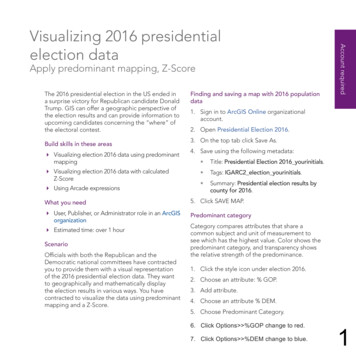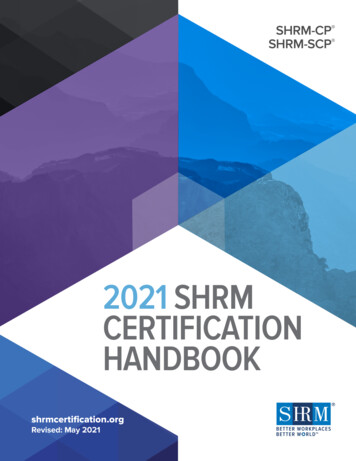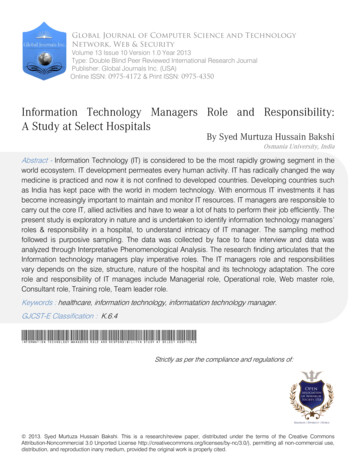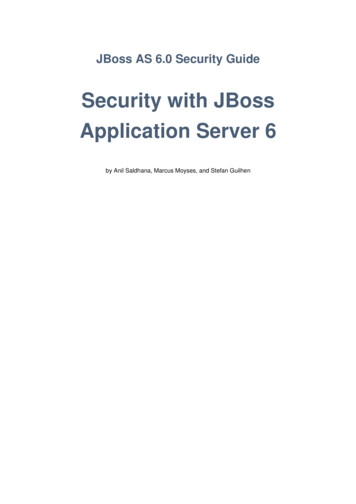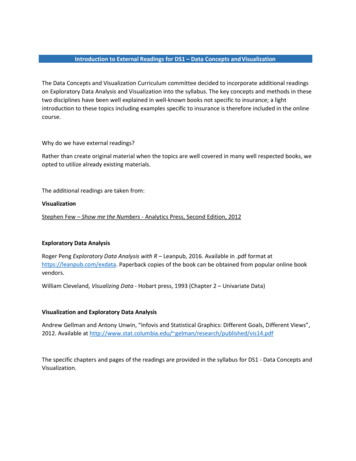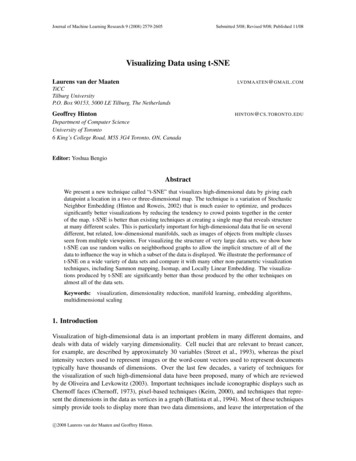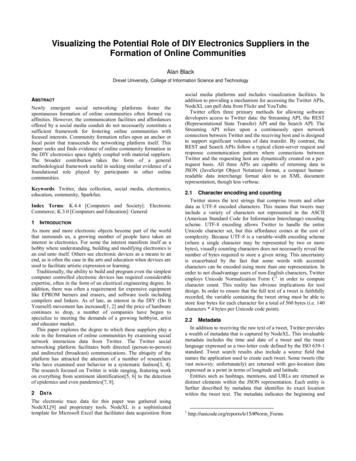
Transcription
Visualizing the Potential Role of DIY Electronics Suppliers in theFormation of Online CommunitiesAlan BlackDrexel University, College of Information Science and TechnologyABSTRACTNewly emergent social networking platforms foster thespontaneous formation of online communities often formed viaaffinities. However, the communication facilities and affordancesoffered by a social media conduit do not necessarily constitute asufficient framework for fostering online communities withfocused interests. Community formation relies upon an anchor orfocal point that transcends the networking platform itself. Thispaper seeks and finds evidence of online community formation inthe DIY electronics space tightly coupled with material suppliers.The broader contribution takes the form of a generalmethodological framework useful in seeking similar evidence of afoundational role played by participants in other onlinecommunities.Keywords: Twitter, data collection, social media, electronics,education, community, Sparkfun.Index Terms: K.4.4 [Computers and Society]: ElectronicCommerce; K.3.0 [Computers and Education]: General1INTRODUCTIONAs more and more electronic objects become part of the worldthat surrounds us, a growing number of people have taken aninterest in electronics. For some the interest manifests itself as ahobby where understanding, building and modifying electronics isan end unto itself. Others see electronic devices as a means to anend, as is often the case in the arts and education when devices areused to facilitate artistic expression or learning.Traditionally, the ability to build and program even the simplestcomputer controlled electronic devices has required considerableexpertise, often in the form of an electrical engineering degree. Inaddition, there was often a requirement for expensive equipmentlike EPROM burners and erasers, and software tools includingcompilers and linkers. As of late, as interest in the DIY (Do ItYourself) movement has increased[1, 2] and the price of hardwarecontinues to drop, a number of companies have begun tospecialize to meeting the demands of a growing hobbyist, artistand educator market.This paper explores the degree to which these suppliers play arole in the formation of online communities by examining socialnetwork interaction data from Twitter. The Twitter socialnetworking platform facilitates both directed (person-to-person)and undirected (broadcast) communications. The ubiquity of theplatform has attracted the attention of a number of researcherswho have examined user behavior in a systematic fashion[3, 4].The research focused on Twitter is wide ranging, featuring workon everything from sentiment identification[5, 6] to the detectionof epidemics and even pandemics[7, 8].2DATAThe electronic trace data for this paper was gathered usingNodeXL[9] and proprietary tools. NodeXL is a sophisticatedtemplate for Microsoft Excel that facilitates data acquisition fromsocial media platforms and includes visualization facilities. Inaddition to providing a mechanism for accessing the Twitter APIs,NodeXL can pull data from Flickr and YouTube.Twitter offers three primary methods for allowing softwaredevelopers access to Twitter data: the Streaming API, the REST(Representational State Transfer) API and the Search API. TheStreaming API relies upon a continuously open networkconnection between Twitter and the receiving host and is designedto support significant volumes of data transfer. By contrast, theREST and Search APIs follow a typical client-server request andresponse communication pattern where connections betweenTwitter and the requesting host are dynamically created on a perrequest basis. All three APIs are capable of returning data inJSON (JavaScript Object Notation) format, a compact humanreadable data interchange format akin to an XML documentrepresentation, though less verbose.2.1 Character encoding and countingTwitter stores the text strings that comprise tweets and otherdata as UTF-8 encoded characters. This means that tweets mayinclude a variety of characters not represented in the ASCII(American Standard Code for Information Interchange) encodingscheme. UTF-8 encoding allows Twitter to handle the entireUnicode character set, but this affordance comes at the cost ofcomplexity. Because UTF-8 is a variable-width encoding scheme(where a single character may be represented by two or morebytes), visually counting characters does not necessarily reveal thenumber of bytes required to store a given string. This uncertaintyis exacerbated by the fact that some words with accentedcharacters can be encoded using more than one representation. Inorder to not disadvantage users of non-English characters, Twitteremploys Unicode Normalization Form C 1 in order to computecharacter count. This reality has obvious implications for tooldesign. In order to ensure that the full text of a tweet is faithfullyrecorded, the variable containing the tweet string must be able tostore four bytes for each character for a total of 560 bytes (i.e. 140characters * 4 bytes per Unicode code point).2.2 MetadataIn addition to receiving the raw text of a tweet, Twitter providesa wealth of metadata that is captured by NodeXL. This invaluablemetadata includes the time and date of a tweet and the tweetlanguage expressed as a two-letter code defined by the ISO 639-1standard. Tweet search results also include a source field thatnames the application used to create each tweet. Some tweets (thevast minority, unfortunately) are returned with geo-location dataexpressed as a point in terms of longitude and latitude.Entities such as hashtags, mentions, and URLs are returned asdistinct elements within the JSON representation. Each entity isfurther described by metadata that identifies its exact locationwithin the tweet text. The metadata indicates the beginning and1http://unicode.org/reports/tr15/#Norm Forms
ending character positions for each entity providing a simplemechanism to calculate entity length.Finally, each tweet returned to NodeXL carries informationregarding the author (i.e. sender). A unique Twitter ID as well as along and a short user name identifies the tweet’s creator. Tweetsthat are directed to a particular Twitter user also contain ID andname data for the intended recipient.2.3 Duplicate tweetsTwitter employs processes to remove duplicate and nearduplicate tweets from search results. The duplication detectiontechnique relies on the MinHash algorithm. A number ofsignatures are computed for each tweet. These signaturesequences are only four bytes in length. A tweet is considered aduplicate if it shares a set of signatures with another tweet.2.4 Result quality and relevanceTwitter filters the results delivered by both the Streaming andthe Search APIs in order to exclude tweets that are deemed lowquality. While the filtering algorithm is unpublished, andtherefore, is likely to change without warning, Twitter doesprovide some insight into the filtering methodology. Frequenttweets that are considered repetitious are targeted for filtering.Twitter also filters tweets from suspended accounts and tweetsthat fail to meet other vaguely defined standards.When working with the search API, the result set may have alsobeen culled based upon relevance. Twitter returns only the mostrelevant tweets pertaining to the query based upon unpublishedcriteria. The relevance filtering process is not imposed on resultsreturned from the Streaming API.3METHODS AND RESULTSIn order to explore the potential role of DIY electronicssuppliers in online community formation, a number of datasetswas retrieved using various modes of operation within NodeXL.Each dataset was then visualized using one or more techniques inorder to gain insight in an attempt to answer the question at hand.Because the domain of interest is often described using broadterms like “DIY”, “electronics”, “hacking”, and others, it wouldbe difficult to execute a search against the Twitter database usingone of these general terms in hopes of isolating the socialinteractions that may provide useful input. In order to alleviatethis problem, the work presented focuses on the social interactionsrelating to a single prominent DIY electronics supplier, SparkFunElectronics. Table 1 details the basic statistics for the SparkFunTwitter account. By focusing on the social media interactionsbetween SparkFun, its followers and others in the DIY electronicsupplier space, lessons may be learned that have implications forthe larger community of DIY electronics suppliers and consumers.Inspection of the word cloud confirms that the subject matter ofthe returned tweets does indeed reflect discussion of SparkFunand DIY electronics in general. Of particular note are the terms“Arduino”, a popular open-source DIY microcontrollerecosystem, “USB”, “RFID” and “Bluetooth”, all commonelectronic communication technologies, and of course “solder”,again reinforcing the DIY nature of the social discourse.Some tweets in the result set were in response to a SparkFuntweet, some explicitly reference SparkFun using the Twittermention affordance (@sparkfun) while others simply contain theterm “sparkfun”. Table 2 summarizes the results.Table 2 – “sparkfun” tweet search resultsMentions36Replies To11Tweet228The figure below shows a network representation of the resultsfor the “sparkfun” keyword search. Nodes with self-directedarrows depict tweets that contain the keyword, while edgesbetween nodes represent affirmative two party communications inthe form of explicit mentions (using the @ affordance) or atargeted communication addressing a particular users (as opposedto a broadcast message). The central node represents the SparkFunuser.Table 1 – SparkFun Electronics Twitter account st, using the NodeXL Twitter search facility, a request wasmade for all tweets in the Twitter index containing the term“sparkfun”. The Twitter index contains tweets at least six days oldand may include tweets up to 9 days old. 276 tweets were returnedin response to the “sparkfun” keyword search.In order to ensure face validity in the result set, and to gaininsight into the content of tweets, a word cloud was constructedusing the raw tweet text, see figure 1 below.In order to better understand the structure of the DIYelectronics supplier community an attempt was made to map therelationships between followers of SparkFun and those who the
followers are following. In other words, NodeXL would be taskedwith retrieving the list of Twitter accounts being followed by eachof SparkFun’s 11,617 followers. Due to data transfer limitsimposed by Twitter, the NodeXL request was limited to 100SparkFun followers (and the accounts that each of them follows).Since each user following SparkFun could also be following anynumber of other Twitter accounts, even when limited to 100SparkFun followers, the result set contained 3,184 node pairsyielding edges in the visualization. The results of this experimentare depicted below.Because SparkFun has 11,617 followers, the limitations placedupon data retrieval by Twitter and limitations in my computinghardware make exploring the role of SparkFun Electronics by wayof follower analysis impractical. In light of this, another methodof seeking evidence of online community building wasimplemented. In this approach, a network of Twitter users thatSparkFun follows (not its followers) serves as the starting pointfor network construction. This method utilizes NodeXL to queryTwitter for the users that SparkFun follows and the other twitteraccounts that those users are following.Even with the 100 follower limitation, the visualization of theresult set is too complex to draw any specific implicationsregarding the topic question with respect to SparkFun Electronics.However, the figure clearly shows clusters within the diagramindicating that there are in fact focal points for communicationswith the DIY electronics community as it pertains to social mediainteracts via Twitter.The figure below shows all nodes that are directly connected toSparkFun (the central node) in red. The red nodes represent theTwitter users that SparkFun follows. This visualization is highlyinformative in that it paints a very clear picture of theinterconnectedness among others in the DIY electronics space thatSparkFun follows. This type of affirmative relationship (choosingto follow another twitter user) yields a strongly interconnect social
graph as the numerous connections among those directlyconnected to SparkFun shows.implies a dearth of direct communications that could foster onlinecommunity development.Limitations imposed by both the Twitter APIs and localcomputing constraints impacted the study’s methodologyprogression. Attempts to build a social network visualizationbased upon SparkFun’s 11,617 followers proved futile. However,4results obtained using only 100 SparkFun followers that includedlinks to each of the users that they were following yielded avisualization that clearly indicated clustering around a handful ofhigh degree nodes.Finally, by taking an approach that began with the manageablenumber of Twitter users that SparkFun Electronics is following(71), there was success in developing a visualization that providesstrong evidence of online community formation centered on aprominent DIY electronics supplier.DISCUSSIONEarly experiments were able to successfully identify relevanttweets that confirmed the quality of result sets as well as offeringinsight into the topics most often discuss in the DIY electronicscommunity over Twitter in the form of keyword identificationthrough the use of a word cloud.Mapping the social media interactions conducted throughTwitter around the “sparkfun” keyword revealed many isolatedreferences to SparkFun. The lack of edges in the sociogram
5CONCLUSIONVisualizing relations of various types (follower, following,mentioned, etc.) within the Twitter social media micro-bloggingweb site appears to provide a valid and useful mechanism forgaining insight into the formation of online communities. In thisstudy, the roll of a particular DIY electronics supplier wasexamined as a potential focal point of community formation.Despite a lack of connectedness among community memberswhen examining simple keyword references, by visualizingrelationships among Twitter users that choose to follow others,clear evidence was developed indicating a strong role for oneparticular supplier in formation of social networks formed aroundan interest in DIY electronics.REFERENCES[1] KERA, D. GRASSROOTS R&D, PROTOTYPE CULTURES ANDDIY INNOVATION: GLOBAL FLOWS OF DATA, KITS AND PROTOCOLS.PERVASIVE ADAPTATION2011), 51.[2] KUZNETSOV, S. AND PAULOS, E. RISE OF THE EXPERTAMATEUR: DIY PROJECTS, COMMUNITIES, AND CULTURES. ACM,CITY, 2010.[3] JAVA, A., SONG, X., FININ, T. AND TSENG, B. WHY WETWITTER: UNDERSTANDING MICROBLOGGING USAGE ANDCOMMUNITIES. ACM, CITY, 2007.[4] HONEY, C. AND HERRING, S. C. BEYOND MICROBLOGGING:CONVERSATION AND COLLABORATION VIA TWITTER. IEEE, CITY,2009.[5] BARBOSA, L. AND FENG, J. ROBUST SENTIMENT DETECTION ONTWITTER FROM BIASED AND NOISY DATA. ASSOCIATION FORCOMPUTATIONAL LINGUISTICS, CITY, 2010.[6] BERMINGHAM, A. AND SMEATON, A. F. CLASSIFYINGSENTIMENT IN MICROBLOGS: IS BREVITY AN ADVANTAGE? ACM,CITY, 2010.[7] CHEW , C. AND EYSENBACH, G. PANDEMICS IN THE AGE OFTWITTER: CONTENT ANALYSIS OF TWEETS DURING THE 2009H1N1 OUTBREAK. PLOS ONE, 5, 11 2010), E14118.[8] CULOTTA, A. TOWARDS DETECTING INFLUENZA EPIDEMICS BYANALYZING TWITTER MESSAGES. ACM, CITY, 2010.[9] SMITH, M. A., SHNEIDERMAN, B., MILIC-FRAYLING, N.,MENDES RODRIGUES, E., BARASH, V., DUNNE, C., CAPONE, T.,PERER, A. AND GLEAVE, E. ANALYZING (SOCIAL MEDIA)NETWORKS WITH NODEXL. ACM, CITY, 2009.
mention affordance (@sparkfun) while others simply contain the term "sparkfun". Table 2 summarizes the results. Table 2 - "sparkfun" tweet search results Mentions 36 Replies To 11 Tweet 228 The figure below shows a network representation of the results for the "sparkfun" keyword search. Nodes with self-directed




